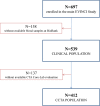Association of PCSK9 plasma levels with metabolic patterns and coronary atherosclerosis in patients with stable angina
- PMID: 31672148
- PMCID: PMC6824037
- DOI: 10.1186/s12933-019-0949-3
Association of PCSK9 plasma levels with metabolic patterns and coronary atherosclerosis in patients with stable angina
Abstract
Objective: Aim of this study was to evaluate the relationship of plasma PCSK9 with metabolic and inflammatory profile and coronary atherosclerotic burden in patients with suspected CAD enrolled in the EVINCI study.
Methods: PCSK9 was measured in 539 patients (60.3 ± 8.6 years, 256 males) with symptoms of CAD characterized by risk factors, bio-humoral profiles, and treatment. N = 412 patients underwent coronary computed tomography angiography (CTA) to assess the presence and characteristics of coronary atherosclerosis. A CTA score, combining extent, severity, composition, and location of plaques was computed.
Results: Patients were divided according to PCSK9 quartiles: I (< 136 ng/mL), II-III (136-266 ng/mL), and IV quartile (> 266 ng/mL). Compared with patients in quartile IV, patients in quartile I had a higher prevalence of the metabolic syndrome and higher values of body mass index. LDL- and HDL-cholesterol were significantly lower in patients in the quartile I than in those in quartile IV. Coronary CTA documented normal vessels in 30% and obstructive CAD in 35% of cases without differences among PCSK9 quartiles. Compared with patients with the highest levels, patients with the lowest PCSK9 levels had a higher CTA score mainly due to higher number of mixed non-obstructive coronary plaques. At multivariable analysis including clinical, medications, and lipid variables, PCSK9 was an independent predictor of the CTA score (coefficient - 0.129, SE 0.03, P < 0.0001), together with age, male gender, statins, interleukin-6, and leptin.
Conclusion: In patients with stable CAD, low PCSK9 plasma levels are associated with a particular metabolic phenotype (low HDL cholesterol, the metabolic syndrome, obesity, insulin resistance and diabetes) and diffuse non-obstructive coronary atherosclerosis. Trial registration ClinicalTrials.gov NCT00979199. Registered September 17, 2009.
Keywords: Coronary atherosclerosis; Metabolic syndrome; PCSK9; Stable angina.
Conflict of interest statement
The authors declare that they have no competing interests.
Figures





References
-
- Baigent C, Keech A, Kearney PM, Blackwell L, Buck G, Pollicino C, Kirby A, Sourjina T, Peto R, Collins R, Simes R, Cholesterol Treatment Trialists’ (CTT) Collaborators Efficacy and safety of cholesterol-lowering treatment: prospective meta-analysis of data from 90,056 participants in 14 randomised trials of statins. Lancet. 2005;366(9493):1267–1278. doi: 10.1016/S0140-6736(05)67394-1. - DOI - PubMed
-
- Allard D, Amsellem S, Abifadel M, Trillard M, Devillers M, Luc G, Krempf M, Reznik Y, Girardet JP, Fredenrich A, Junien C, Varret M, Boileau C, Benlian P, Rabès JP. Novel mutations of the PCSK9 gene cause variable phenotype of autosomal dominant hypercholesterolemia. Hum Mutat. 2005;26(5):497. doi: 10.1002/humu.9383. - DOI - PubMed
Publication types
MeSH terms
Substances
Associated data
LinkOut - more resources
Full Text Sources
Medical
Miscellaneous

